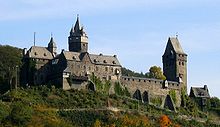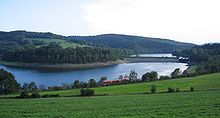South Westphalia (German: Südwestfalen) is a region in North Rhine-Westphalia, Germany. It consists of Sauerland, Siegerland and some smaller sub-regions and is the most sparsely populated region of the state. The landscape is characterised by rolling hills and (low) mountain ranges, making Sauerland and the Rothaar Mountains one of Germany's northernmost skiing areas. Beyond winter sports, the region is popular for hiking, camping and its small and romantic historical towns.
Cities[edit]


- 1 Arnsberg, administrative centre of the region
- 2 Freudenberg, one of the best-preserved old towns with a complete ensemble of half-timbered houses
- 3 Iserlohn
- 4 Lüdenscheid
- 5 Meschede
- 6 Schmallenberg
- 7 Siegen
- 8 Soest, historical city with well-preserved medieval core, huge funfair in November
- 9 Winterberg, skiing resort
Other destinations[edit]
Understand[edit]
South Westphalia consists of several smaller sub-regions — Sauerland, Siegerland, Wittgensteiner Land, Soester Börde, etc. — each of which has its own traditions, customs and a population proud of their regional identity.
Talk[edit]
The times when every village in the region had its own local variety of the Low German (in the North) or Moselle Franconian language (in the south) are long gone. Only some bits of the old vocabularies are still present in today's language and some peculiarities in pronunciation remain. Most notably, people of the Siegerland are known for pronouncing their R's in a rather un-German way that sounds very North American. Other than that, you will find the spoken language to be rather standard German that should not be too difficult to understand.
As everywhere in western Germany, everyone but the oldest generation has learned at least some basic English in school. But since few tourists and business travelers from English-speaking countries make it to the area, many are out of practice and you may find yourself talking with your hands and feet as well on occasion. In the more touristy parts of the Rothaar Mountains, it is not uncommon to find signs in Dutch, and the owner of your hotel or restaurant may well turn out to be an immigrant from the Netherlands.
Get in[edit]
By plane[edit]
There is a regional airport in Paderborn-Lippstadt (PAD IATA) offering a few domestic and seasonal charter connections to holiday destinations around the Mediterranean. The "Siegerland airport" near Burbach (SGE IATA) can only be reached by charter and private flights. More important nearby airports are Dortmund (DTM IATA, 45 km to the Northwest), Düsseldorf (DUS IATA, 95 km to the West) and Cologne (CGN IATA, 70 km to the West), the two last-mentioned offer a wide range of international connections.
By train[edit]
Hagen, the "gate to Sauerland" is reached by high-speed trains (ICE) from Berlin and Cologne hourly, additionally there are ordinary intercity trains from Dresden every two hours. Soest and Lippstadt have a few ICE trains from Würzburg and Düsseldorf per day. Most parts of the region can only be reached by (frequently running) regional trains.
Get around[edit]
See[edit]

In this region, there is a number of historic towns with well-preserved medieval cores. Soest is arguably the historically and culturally most notable among them. Other recommended destinations are Lüdenscheid with its circular medieval layout; or Freudenberg, Brilon, Arnsberg, Bad Berleburg, Bad Laasphe (18 km south of Berleburg), Burbach (22 km south of Siegen), Hilchenbach (19 km northeast of Siegen) and Schmallenberg (22 km west of Winterberg) with their romantic ensembles of old, half-timbered houses, picturesque steeples and narrow lanes.

There are several castles worth seeing, including Altena Castle (a medieval spur castle that has been reconstructed in the 19th century; 14 km north of Lüdenscheid), Oberes Schloss of Siegen or Schloss Berleburg.
Further attractions are the Heinrichs's cave (limestone cave with fossiles and skeletons of primeval animals) in Hemer (6 km east of Iserlohn) and the Berg Kappe mountain panoramic bridge near Winterberg.
Do[edit]

Sauerland and Rothaar Mountains are popular skiing destinations, mostly frequented by Northern Germans and Dutch who don't want to go the far way to the Alps. There is a well-developed skiing infrastructure with ski-lifts, jumps etc.
Moreover, there are many scenic hiking trails, cycling paths, lakes and reservoirs for swimming, water sports and camping.
During the week of All Saints' Day, the whole old town of Soest is transformed into a funfair area which claims to be Europe's biggest funfair held in an old town (rather than on a separate site outside the town), attracting more than a million visitors per year to the small town of less than 50,000 inhabitants.
Eat[edit]
The traditional Westphalian cuisine is known for its hearty, meat-based dishes that stem from a time where hard labour was the norm. South Westphalia is known for its brown bread (Pumpernickel—a heavy, slightly sweet rye bread), ham and Wurst (i. e. sausages and lunchmeat) specialties. Fish does not play a major role, but as the low mountain ranges provide an abundance of clear brooks and creeks, chances of finding fresh trout on the menu are pretty good.
- Potthucke – casserole from the Sauerland, made with mashed and grated potatoes, eggs, cream and bacon. Originally a dish for the poor, today it is served (in a more refined version) in specialised restaurants.
- Dicke Bohnen mit Speck – is a hearty dish made from baked broad beans and bacon, often served with boiled potatoes and Mettwurst.
- Sejerlänner Riewekooche – is a bread specialty from the Siegerland, were some or even all of the normal flour is replaced by grated raw potatoes.
- Knochenwurst (lit.: "bone sausage") – a type of lunch meat that contains chunks of bone, usually served warm together with other hearty dishes. Another former poor people's dish that turned into a local speciality of the Winterberg/Medebach region. And no, you are of course not supposed to eat the bone – just gnaw off the meat and then put them aside.
Drink[edit]

South Westphalia is home to three of Germany's best-selling beer brands: Krombacher (no. 2 in Germany), Veltins (no. 4) and Warsteiner (no. 6). Beer afficionados however criticise them for being too "mainstream" and make them responsible for a loss of diversity in smaller local breweries. As a matter of fact, many people—including experts—are unable to distinguish their default Pilsner beers by taste in blind tests. Fortunately, you will still find a number of individual breweries that produce according to their traditional recipes and have resisted the big corporations' bids. With traditional and non-standard beers gaining popularity again in Germany since the 2010s, the "big 3" jumped on the craft beer train and are now offering some alternatives to their Pilsners.
Sleep[edit]
Stay safe[edit]
Go next[edit]

